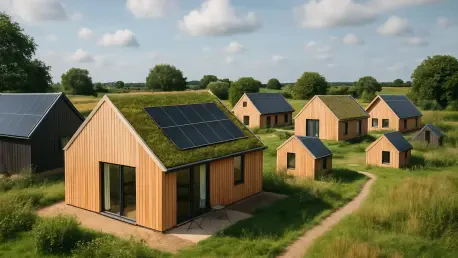Imagine a rural village in Suffolk, nestled near the vibrant coast of Southwold, facing the dual pressures of housing scarcity and environmental challenges, where a new development promises to redefine community living with a focus on affordability and eco-conscious design. This roundup explores diverse opinions, insights, and tips from industry professionals, environmental advocates, and housing experts on Copperwheat Place, a 220-home project by Orbit Homes in Reydon. The aim is to uncover how this initiative balances human needs with ecological responsibility, and what lessons it offers for the future of rural housing across the UK.
Diverse Views on Affordable and Inclusive Housing
Industry observers have noted that affordability remains a critical concern in rural areas like Suffolk, where housing often comes at a premium. Copperwheat Place addresses this by designating 118 of its 220 homes for affordable rent or Shared Ownership, a move praised by housing policy analysts for broadening access. Market sale options and self-build plots further diversify the mix, catering to a spectrum of financial capacities.
However, some skeptics question whether such a high proportion of affordable units can maintain quality standards without compromising on design or amenities. Urban planners argue that while the inclusion of one- to four-bedroom houses and bungalows shows versatility, the challenge lies in ensuring long-term maintenance and community integration in a rural context. This sparks debate on scalability in less densely populated regions.
A contrasting perspective comes from community advocates who emphasize the project’s inclusivity, particularly the allocation of seven homes for residents displaced by coastal erosion. This tailored solution has been hailed as a model for addressing regional challenges, though some caution that such niche provisions might not be replicable on a larger scale without significant funding or policy support.
Sustainability Innovations: Applause and Apprehensions
Environmental groups have lauded Copperwheat Place for its commitment to green living, spotlighting features like air source heat pumps, electric vehicle charging points, and enhanced insulation. These align with broader industry trends toward energy efficiency, reducing both costs and carbon footprints for residents. Advocates argue that such advancements set a benchmark for other developers in the region.
On the flip side, construction experts highlight potential drawbacks, suggesting that integrating high-end sustainable technologies could elevate initial costs, possibly deterring some buyers. There’s a concern that while Orbit Group’s goal of supporting nature recovery in 30% of outdoor spaces by 2030 is ambitious, it might strain budgets if not balanced with practical financial planning. This tension between innovation and affordability remains a point of contention.
Biodiversity proponents offer a more optimistic take, focusing on nature-positive additions like hedgehog highways and bird nesting boxes under the ‘Homes for Nature’ initiative. They contend that these elements not only enhance local ecosystems but also improve resident well-being by fostering a connection to the environment. This perspective underscores a growing demand for developments that prioritize ecological harmony.
Community Design and Safety: Building Beyond Bricks
Urban designers have expressed admiration for the emphasis on communal spaces at Copperwheat Place, including green areas, children’s play zones, and connecting footpaths. These features are seen as vital for creating cohesive neighborhoods, especially in rural settings where isolation can be a concern. The integration of such amenities is often cited as a step above traditional developments that prioritize housing units over shared environments.
Safety considerations also garner positive feedback, with the project adhering to high standards aligned with frameworks for preventing household accidents. Infrastructure specialists point out that this focus on safe design could reduce long-term risks and liabilities, setting a precedent for other rural projects. Yet, some question whether these standards might increase construction timelines or costs, potentially affecting delivery schedules.
A differing viewpoint from resident-focused organizations suggests that while shared spaces and safety measures are promising, their success hinges on active community engagement post-construction. They argue that without sustained efforts to build social ties, even well-designed areas risk underutilization. This highlights the need for ongoing programs or initiatives to nurture a sense of belonging among residents.
Regional Impact and Comparative Insights
Housing market analysts have positioned Copperwheat Place within Orbit Homes’ broader portfolio in Suffolk, comparing it to projects like Homestead Park in Stonham Aspal and Weavers Grove in Bildeston. The consensus is that this development stands out for its dual focus on regional issues like coastal erosion and universal needs like affordability. Such targeted approaches are seen as a strength in addressing local disparities.
Conversely, some regional planners argue that while Orbit Homes demonstrates a strong presence in the area, the impact of niche solutions like homes for erosion-affected residents might be limited without wider governmental collaboration. They suggest that partnerships with local authorities could amplify the reach and effectiveness of such initiatives, a viewpoint that calls for systemic support over isolated efforts.
Environmental consultants add another layer, noting that the project’s sustainability features could inspire similar developments across East Anglia. However, they caution that regional variations in climate, economy, and policy might hinder direct replication. This comparison reveals both the potential and the limitations of Copperwheat Place as a blueprint for other rural communities.
Reflecting on a Vision for Sustainable Living
Looking back, the discussions around Copperwheat Place revealed a rich tapestry of perspectives, from admiration for its affordability and green innovations to concerns over cost implications and scalability. Experts across housing, environment, and urban design fields largely agreed on its potential as a model, yet differed on the practical hurdles of implementation. The dialogue underscored a shared recognition of the need for inclusive, eco-friendly communities in rural settings.
For developers and policymakers, the insights pointed toward actionable strategies like fostering public-private partnerships to support affordable housing and adopting biodiversity goals in planning phases. Housing advocates also recommended that future projects prioritize resident feedback to ensure communal spaces meet evolving needs. For those intrigued by this balance of human and ecological priorities, exploring Orbit Homes’ resources offers a deeper dive into sustainable living solutions, paving the way for informed decisions and inspired action.









